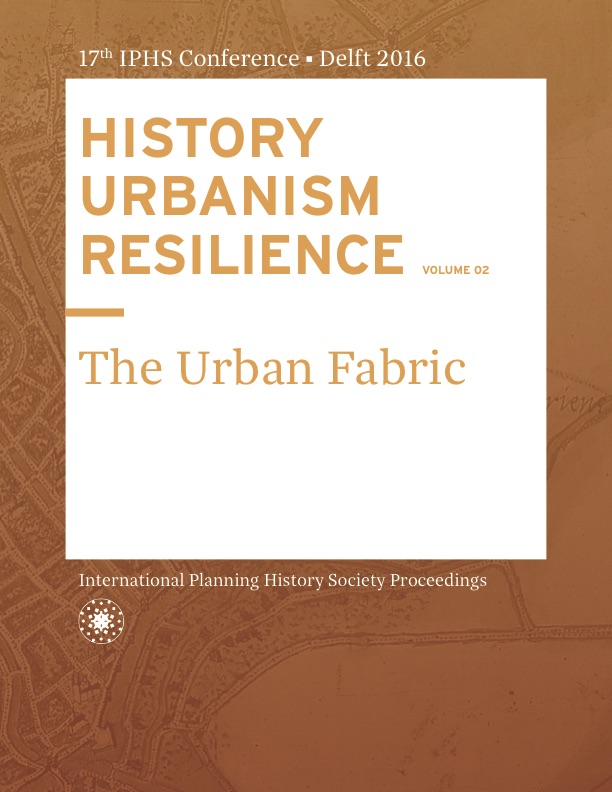From Street Network Analysis to Urban History
DOI:
https://doi.org/10.7480/iphs.2016.2.1249Abstract
The morphological analysis states that changes in urban form operate following a transitional system, which obeys a partially binding endogenous logic. This aspect has been heavily criticised for the bait it may induce, through the suggestion of an auto-perpetuation of urban forms. Actually, form's autonomy has a social as well as a morphological origin: it comes from the multiplicity of its functions, senses, and the multiplicity of actors. Nevertheless, the complexity of this social/spatial articulation might be the morphological analysis’ best asset. Indeed, it suggests that a theory of urban form’s evolution should rely on models which simplify reality, in order to focus on a single aspect: the form itself, for instance.Furthermore, the modelling that I propose focuses on a single component of urban form: the street network. Therefore, my aim is to know how the analysis of the street network’s evolution will bring me insights about the city’s formative process.
Some authors have insisted on the necessity of perceiving these process as an action-retroaction mechanism: on the one hand, local modifications (such as adding a street) that occur in the street network have an impact on its global properties (in terms of density or centrality e.g.); on the other hand, the global network yields a conditioning on its elements’ substitution, which provokes, at least during a period of time, the stability of its global properties.
The purpose of this communication is to expose this interplay between Bottom-up and Top-down processes. To achieve that, I compare the morphological properties of street networks, in a diachronic way, on long time periods. Then, I show how this comparison reveals the impact of local modifications on the network’s global properties, and reciprocally, how those properties sometimes remain stable despite local modifications. Finally, I introduce the external context (historical, political, socio-economic…) for each period, and look for regularities in causes of the observed impacts or remains. Those regularities will be sought in terms of exogenous reasons: are there categories of modifications (wars, urban sprawl…) that are more impactful than others? And then in terms of endogenous laws: are there network’s patterns that are more yielding, or more rigid than others?
In order to test the relevance of my approach, I work on two very different case studies: Paris, the capital of France, and Beauvais, a small town in northern France. An interesting result was obtained on the city of Beauvais, by analysing the network’s accessibility and density, as well as the street’s width distribution (the number of streets for each width category) before and after World War II. I demonstrated a relative stability of the network’s properties for a certain time before the War, and then a deep modification after 1960’s reconstruction. A comparison of those parameters among others, on a longer time, for my two case studies, then the introduction of each context may allow me to show the regularities mentioned before, and could lead me to reveal generic city’s formative processes.
References
Albert, Réka and Albert-László Baraba ́si, « Statistical mechanics of complex networks », Reviews of Modern Physics, 74 (2002) : 47–97.
Barthelemy, Marc, Patricia Bordin, Henri Berestycki, and Maurizio Gribaudi, « Self- organization versus top-down planning in the evolution of a city », Scientific reports, 3 (2013).
Caniggia Gianfranco, Lecture de Florence. Une approche morphologique de la ville et du territoire. Etude des processus de formation des tissus urbains. Bruxelles : institut supérieur d’architecture Saint-Luc, 1994, 142 p.
Duprat, Bernard, Morphologie appliquée : L’analyse des conformations architecturales, ses problèmes, ses principes, ses méthodes, Lyon : Université Jean Moulin Lyon III Faculté de philosophie, 1999 : 2-10.
Freeman, Linton C. « A set of measures of centrality based on betweenness », Sociometry, 40 (1977) : 35–41.
Gauthiez, Bernard, Elisabeth Zadora-Rio, Henri Galinié, Village et ville au Moyen Age : les dynamiques morphologiques, Tours, 2003 : 13-27
Hillier, Bill, J. Hanson, The social logic of space, Cambridge university press, 1989.
Lagesse, Claire, Patricia Bordin, and Stephane Douady, « A spatial multi-scale object to analyze road networks », Network Science, 3 (2015) : 156–181.
Lepetit Bernard, Pierre Merlin (éd.), « Morphologie urbaine et parcellaire : Formes urbaines, villes en parallèle », In Annales. Économies, Sociétés, Civilisations, 469-470, 1990.
Marshall, Stephen, Streets and Patterns, London and New York: Spon Press, 2005.
Mohajeri, Nahid, Jon R. French, Michael Batty, « Evolution and entropy in the organization of urban street patterns », Annals of GIS, 19,1, (2013) : 1-16.
Porta, Sergio, Ombretta Romice, J Alexander Maxwell, Peter Russell and Darren Baird, « Alterations in scale: Patterns of change in main street networks across time and space », Urban Studies, 51, 3383 (2014).
Salat Serge, Les villes et les formes, sur l’urbanisme durable, -1e éd. Paris: Hermann, 2011, 544 p.
Strano, E., V. Nicosia, V. Latora, S. Porta, M. Barthelemy, « Elementary processes governing the evolution of road networks », Scientific Reports, 2, 296 (2012).
Ville de Beauvais, Dossier de candidature au label Villes et pays d’art et d’histoire, Beauvais : Ville de Beauvais, 164 p.

